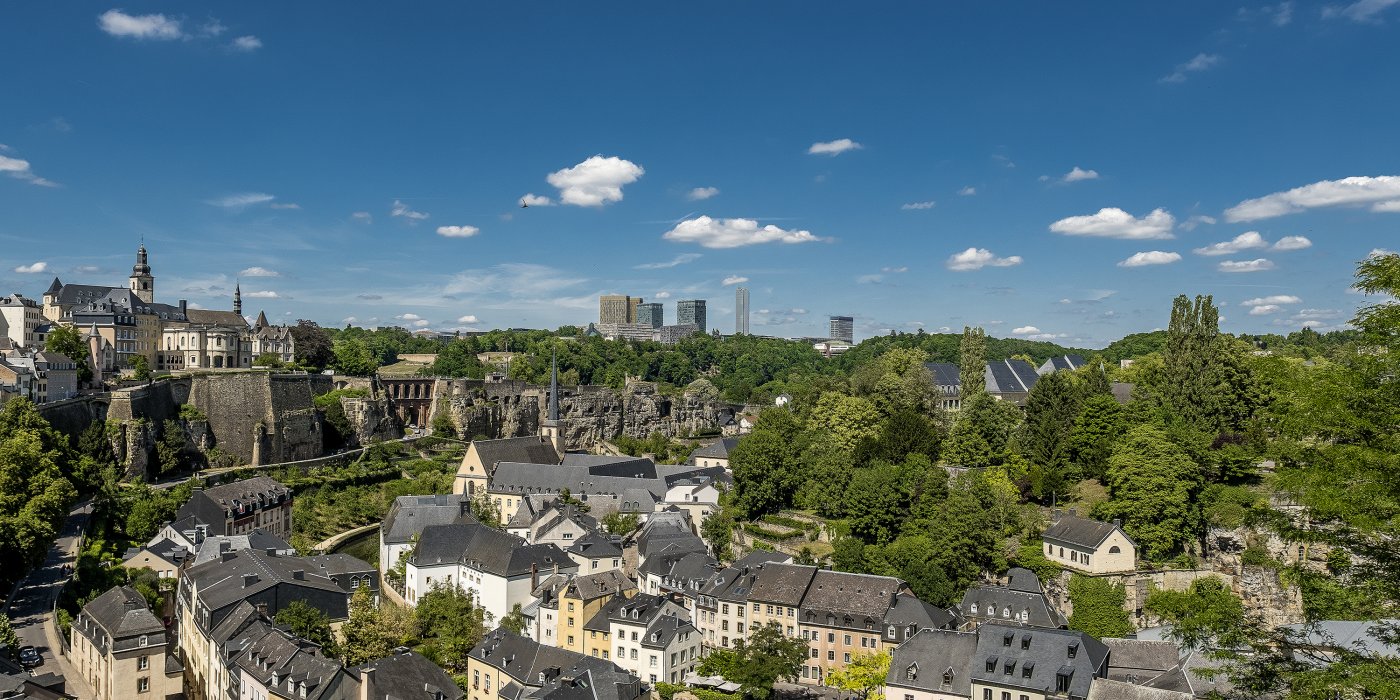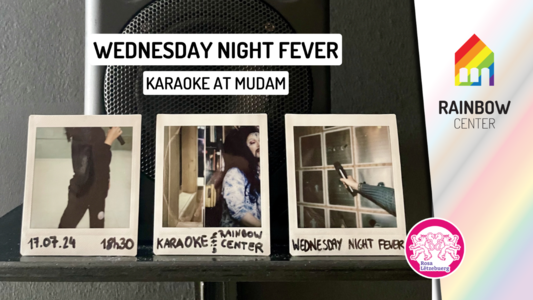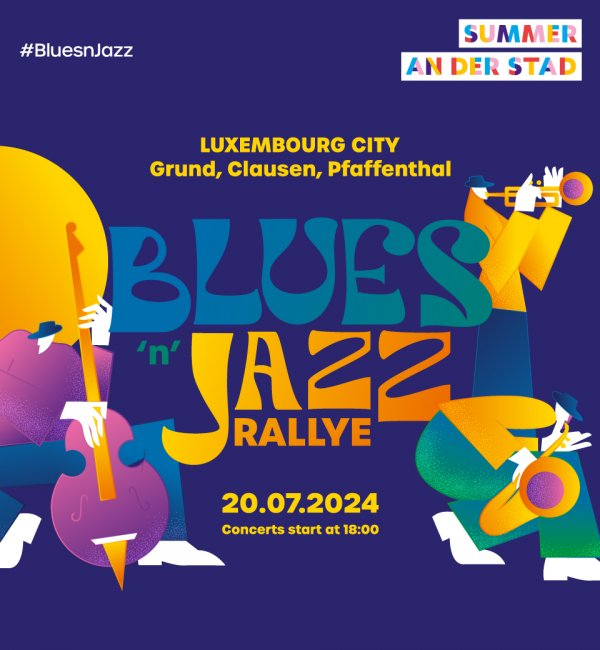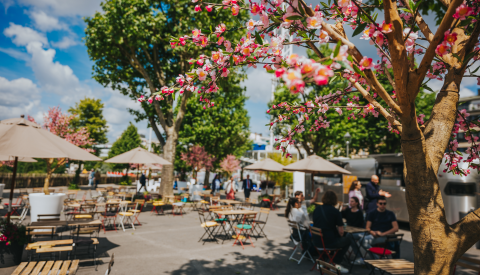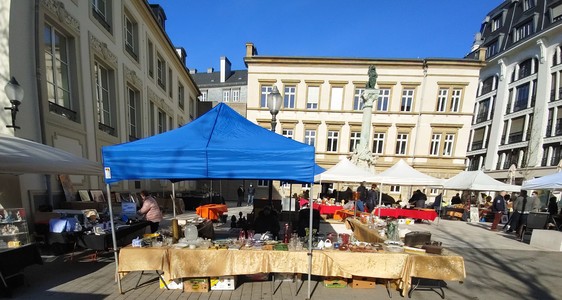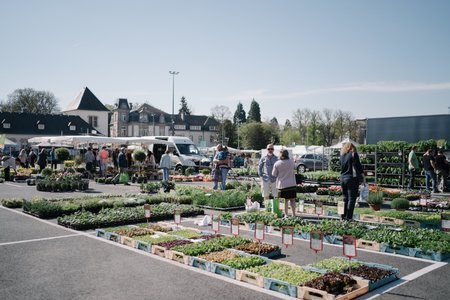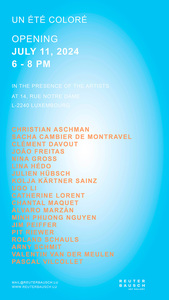
Date
to 10.08 at 19:00 - 2024
Place
rue Notre Dame
2240 Luxembourg
‘Un été coloré’ brings together 19 of our artists, as well as new artists in our gallery.
Each artist exhibits one of his/her works, regardless of technique or medium.
Below is a short biography of each artist.
CHRISTIAN ASCHMAN
Born in Luxembourg in 1966, Christian Aschman lives and works in Luxembourg.
Christian is a freelance photographer, who worked on countless photo shootings for fashion shows, portraits and commissioned photographs depicting cities, construction sites and various architecture.
Varying the way he exhibits his images – he sometimes sticks them on posters in public places in the streets of Paris or exhibits them deconstructed – he decided this time to show the full image. Nine years after their date of shooting, these photographs with simple forms constitute a body of images that can be randomly placed in space.In a conversation with Christian Aschman, the critic Stéphane Léger made the following statement: “When I look at your photographic production in the metropolises and capitals of the world over nearly twenty years, I cannot qualify it as architectural photography, even if the latter constitutes its substance or matter. I also have the feeling that these simple forms that you have been photographing for a long time cannot be exhausted, that in their simplicity they open up a multiplicity of gazes in a temporal continuum.”
SACHA CAMBIER DE MONTRAVEL
A native of Liège, Sacha Cambier de Montravel first studied drawing at La Cambre in Brussels, then went on to study at the Beaux-Arts in Paris, where his artistic practices varied between painting, installation, and volume. Immersed for many years in a philosophical, historical, and literary quest for violence and eroticism, he is now seeking to formulate a way of thinking that is the plastic heir to the thought of Georges Bataille, Nietzche and Sade, as well as other thinkers who have shaped his imagination and his statements.
CLÉMENT DAVOUT
Clément Davout paints shadows of plants. In a short text presenting his work, he writes that he practices a painting «with a figurative tendency». The expression is remarkable, it places the work in an in- between, a grey zone. The shadow is not the motif itself but its projection. The shadows painted by Clément Davout are diffuse, evanescent, mobile, and are therefore not so much drawing as «matter that aspires to form», as Hubert Damisch puts it in relation to the cloud.
The artist, who has removed black from his palette, associates these shadows with a background painted in the same shades of color, the variations of which restore a diaphanous luminosity. One might think that Clément Davout paints paint. Conversely, one could dwell on the subject of these works, the choice of this domesticated nature which refers to the immediate environment in its simplicity and banality. But the essential is perhaps more in the tension that this approach produces with the image. Working with photographs, these projected shadows become colored vibrations of the pictorial material, they are then inscribed as a fragment in a surface whose color corresponds, in painting, to a color chart obtained by placing the work on Instagram. In this back and forth, it is a question of bringing back into painting what could only be an image with the regime of diffusion that currently defines it.
We can understand to what extent this practice is inscribed in today’s world as a form of discreet resistance. In a world that claims transparency, where everyone is an actor through social networks and where a univocal relationship to things prevails, the choice of the shadow can only be a challenge. It is the choice of the troubled and the uncertain, of the repressed and the elusive.
Romain Mathieu (After School Biennial Artpress)
JOÃO FREITAS
João Freitas’s work is linked to the notion of trace, wear and tear, time, and he treats the structures that support him like skinned men: paper, cardboard, fabric, glass paper, wood, etc. The artist’s intention is to gently violate the material to make it say something elusive, just as an anatomy sheet reveals the true structures and components of an organism.
With Freitas, there is a desire to reveal, to lift up matter, to give it a mystical meaning by revealing its mysteries and mutations, just as the work of the alchemist transmutes matter into ethers, vapours and other essences.
João Freitas is one of those artists who learn from his own work. Nothing seems decided at the outset of his dissections; he finds by searching, like an archaeologist unearthing a buried object. As an apprentice aesthete, sensitive and attentive, he looks for unlimited combinations of effects and games in these artefacts, generating an infinite poetry that does not exclude violence. And so, in this relationship with matter that is at once brutal and suave, he succeeds in making us resonate with these ineffable questions of time, tangibility and presence, becoming, in his crucible, a durable, touching and immanent material.
NINA GROSS
Nina Gross’s artistic practice deals with anthropology and questions how we relate to the objects of our daily lives. Banal and obvious objects, such as forks and spoons, are isolated from the context of their cultural use and translated into small paintings. Like another film, it stops the narrative and routine in which they are used. The economical brush strokes allude to Alex Katz and reflect the strength of painting to represent textures and surfaces.
Observation, drawing and the photographic eye attract objects to still life. The distance allows their story to emerge and transforms kitchen tools into fragmented, more abstract images. It triggers our association for the meaning of things depends on their use. In this sense, kitchen tools can have ambiguous uses depending on the intentions of the users. The knife, for example, can be both a domestic and a dangerous tool.
Bathroom scenes explore washing routines and activities that are visible in the mirror but physically incompatible. He wonders where the illusion begins and what element of the image can be taken for real. Love relation of hate depicts the between the space of the soap and the water tap. Both cannot be used with each other near.
LINA HÉDO
Lina Hédo, born in 1999, is an aspiring artist from Luxembourg. As a fine arts graduate from Paris,
her artwork represents a vessel through which she communicates powerful emotions.
At the core of her artistic expression lies a strong connection to the human figure and its emotions.
Through her chosen medium, the art of painting, she aims to create a dialogue between figuration and abstraction. Through the human figure at the center of her artistic creations, she aims to forge an emotional connection between the artwork and the observer. Often non-gendered, the figures displayed stay anonymous and open to interpretation. Emphasizing expression over perfection, her inituitive creative approached is marked by her usage of colours and bold brushstrokes.
JULIEN HÜBSCH
Julien Hübsch (*1995) graduated from the Expanded Painting class under Shannon Bool at the Kunsthochschule Mainz in July 2023.
In his artistic work, he explores urban spaces and the altered cityscape, aligning himself with the Post-Vandalism art movement. Hübsch is particularly drawn to everyday human-made traces. He abstractly translates what he observes into his work, focusing on the aesthetic result when removing the context of these «everyday traces.»
Materials play a dominant role, serving as the starting point for his concepts. His works span various forms, including installations, assemblages, expanded painting, and sculpture, making him a multimedia artist. His works are rooted in the Post-Vandalism movement, often reflecting the raw aesthetics of urban interventions such as graffiti, vandalism, protests, and illegal art actions.
Hübsch draws inspiration from urban interventions and the societal response to vandalism. Abandoned sites and non-places also inspire him. These locations, devoid of artistic intent, challenge him to observe abstract compositions inadvertently found in urban spaces.
UGO LI
Born in 1987 in Paris, Ugo Li lives and works in Paris, France.
Improvisation is at the heart of his work. Time is his ally and painting imposes itself on him like an injunction. It dictates his brushstrokes. His work is not abstract or figurative. His paintings are the result of a process of experiences, a way of physically transposing representations accumulated in his memory. It can be the retranscription of punctual and ontological emotions, or of precise events linked to her life: autobiography is very close and sweeps through the essence of her work.
His practice of painting is also part of the time necessary to execute a painting with its multiple layers successively deposited on the canvas. He ironed, crossed out, erased, crossed out, leaving, most often, only a tiny part of the initial drawing. This process tends to achieve the expression of painting as a dialogue, a quest for pictorial emotion.
The wanderings on the canvas provoke the explosion by the multiplication of elements and colors, before offering a new visual coherence. Each painting is a surface, or even a stage, on which an open mechanics unfolds, the rules of which are in no way laid down in advance: the motifs follow the law of associations of forms and ideas, they are constantly transforming. In some of his paintings, he plays with signs, words and isolated images. Thus, the signs are silent, they say nothing, they do not want to announce any clue, they are pictorial elements or rather a kind of pictorial zapping whose global deciphering belongs to each spectator.
CATHERINE LORENT
Catherine Lorent was born in 1977 in Munich, Germany, and lives and works in Berlin, Germany. She has exhibited in Germany, France, the Netherlands, Switzerland, Austria and Luxembourg and has won the 2005 Young Artists Incentive Prize and the 2011 Revelation Prize from the Ministry of Culture in Luxembourg, she also represented Luxembourg at the Robert Schuman Prize in 2011.
Awarded the 2021 Grand Duke Adolphe Prize, Catherine Lorent has long been one of the country’s dedicated artists. Although her studio has been established for more than fifteen years in Berlin, Lorent does not decline her life as an artist in a «somewhere», but rather in a «universe» linking post-punk music and contemporary visual arts, like his frachs under his musical project Gran Horno and some of his long-term artistic projects such as Relegation, initiated for his occupation of the Luxembourg Pavilion, at the 55th Venice Art Biennale in 2013. Since the beginning of his studies at the Academy of Fine Arts in Karlsruhe, the artist has never stopped perfecting an exemplary artistic education, while deconstructing these precepts with great fusion between art and music, abstraction and figuration, pointed references and pop wink, improv and concept. Lorent wants to bring spectators into the exchange, eager to make clash cultural traditions and artistic rantings.
CHANTAL MAQUET
Born 1982 in Luxembourg. Lives in Hamburg.
Chantal Maquet is a multidisciplinary artist with a focus on drawing and painting. The starting point of her artistic work are reflections on female role clichés and their breaking through. She examines individual and collective behavioural patterns that shape social dynamics. In her figurative works, the colours are detached from real references. Unexpected colour combinations underline moods and change the atmosphere of the depicted scenes. The distrust of first impressions is reinforced by the poetic frame set by the titles of the works. In her exhibitions, Chantal Maquet combines painting with video works and interactive sound installations.
ÀLVARO MARZÀN
My artistic work focuses on painting, around subjects such as the universal search for identity or the intrinsic need of human beings to understand their own nature and question the ultimate meaning of what surrounds them. It is from a deep commitment to painting and contemporary creation that I propose a world between the physical and the metaphysical, extravagant and mysterious, passionately unreal, that can offer from its distorted surface an ephemeral reflection of all that is invisible to us.
My images emanate from the subconscious, which I consider to be an abstract space, the place of pre-language. This is where things have no assigned functional meaning, and where imagination plays a fundamental role. From my point of view, it’s the space where children play at understanding their environment by inventing their own rules. In this space, I find elements that are constantly transforming into one another and that have a strong symbolic value. The body, the feminine, the masculine, the animal, nature and consciousness. Together, they build a dynamic, allegorical pictorial narrative. Through honest research, I hope to find real elements.
As a material, I use painting for its ability to define scenarios and situations with its own rules, totally coherent inclusive universes, which I propose as an analogy with our ability to create our own realities. In this way, my work also reclaims painting as a means of contemporary creation. Through material, form and color, it asserts its semantic value; its ability to establish a language and a perfectly efficient non-verbal communication. An extraordinarily poetic vehicle for the thought process, capable of appealing to the purely emotional side of our minds.
MINH PHUONG NGUYEN
Born in 1999, Bitburg, Germany.
„Growing up between the German and Vietnamese cultures, I deal in my artistic process with questions of my origin, childhood and identity. In doing so, I am always in critical reflection with society and my surroundings: How do I understand the culture I grew up with? To what extent does it define me and how close do I let it get to me? These questions represent approaches to my work and are formative for my own past and future development. I transform my own creative dynamics and power into fast forms and movements. For this I use the media of painting, drawings and installations. I am fascinated by surfaces, reflections and the resulting light reflections, which I break downin my thinking and in my artistic implementation analytically, but also metaphorically. Abstract forms and movements, which for me can convey a wide variety of emotions depending on the situation, I try to combine in the figurative. These elements are therefore also an important part of my work, in which I unite the intermediate world of the tangible and intangible.“ Minh Phương Nguyễn
JIM PEIFFER
In his work, Jim Peiffer proposes a mode of composition in which the artist is the subject or actor, and the object present or absent. His works are painted, drawn or sculpted on wood, canvas or a variety of other media.
«The strange boat, the protective cushion under the head, allude to batches of royal images where, in most «civilizations», the head of the deceased rests on a cushion of distinction. The boat is both tomb and sarcophagus. This brings to mind the Viking boats preserved in Scandinavian museums, and the Kwakiutl representation of the sea: a river flowing northwards, where the underworld opens up and dead souls join supernatural spirits...
Jim Peiffer’s ceaselessly created and re-created worlds also invite us to «circumnavigate», to go towards those poles where the differentiated times of history and experience merge in a salvific way. Hence, perhaps, the disturbing yet visually soothing sensation of the tenuous passage from childhood to adulthood. For this body, borrowed from rough «primitivist» sculptures, simultaneously takes us back to countless representations of early childhood, such as Giotto’s swaddled Infant Jesus. Like Jim Peiffer’s reclining figure, the swaddled newborns are literally encased, imprisoned as if in a straitjacket, in their swaddling clothes, i.e. in the socially-appropriate confinement of the human civitas. The installation thus shifts from one iconographic register to another...
Finally, the two paintings Jim Peiffer added to this ensemble reinforce its meaning and scope: one depicts disquieting heads emerging from the black darkness of an immaterial background; the other pours out, disembarking, from a strange «boat car» virtually all the creatures on the planet to be preserved. A Noah’s Ark transcending disaster and the ocean’s journey to infinity?»
Bernard Ceysson
PIT RIEWER
In my artistic practice, I delve into deconstructing imagery from my personal archive, aiming to capture the dynamic energy and cinematic atmosphere of fleeting moments. Many of the photographs that serve as the starting point for my paintings depict nocturnal scenes, often blurry and enigmatic. These snapshots, originating from a painterly impulse, lack definitive information and detail, allowing for interpretation and reconstruction. I am interested in the inherent ambiguity and incompleteness of these photographs, offering an openness to complete an image in a way only painting can.
Drawing from my profound interest in impressionism and abstract expressionism, the surface acts as a stage onto which brushstrokes, often limited to horizontal and vertical directions, are projected onto. The brushstroke and gesture are essential in creating rhythm and energy akin to the cadence of music. It is through this meticulous process and use of vivid colour that the images move further away from the reference photograph and become independent paintings.
Within my work, I craft atmospheric narratives reminiscent of visual storytelling in film. Through repetitive gestures and a formalistic approach, I explore the transient nature of moments, transforming flat spaces into vibrant colourful compositions that evoke contemplation and emotion. By embracing and accepting abstraction, I strive to create works that evoke a sense of emotional depth and timeless melancholy.
ROLAND SCHAULS
Luxembourgish artist Roland Schauls is internationally recognized for his artworks. He completed his artistic studies at the State Academy of Fine Arts in Stuttgart, and today, he divides his artistic life between neighboring Luxembourg and the city of Stuttgart. Schauls’ most iconic work is undoubtedly «Portrait Society,» in which he reimagined and reinterpreted 504 portraits of old masters.
Portraiture has become the central theme of this artist’s work, which he explores through both individual portraits and group compositions. He aims to offer a wide range of interpretations for his creations, hoping that the viewer perceives the painting for what it is, beyond any illustrative representation. The titles of his works carry a touch of irony, encouraging the viewer to imagine their own story behind the depicted subjects.
Schauls’ creations evoke the early 20th-century art avant-garde while incorporating contemporary elements. One can discover modern furniture on one side and contemporary attire on the other in his paintings. His artworks are rich in details, including an initially perplexing spatial design that skillfully plays with the viewer’s visual habits. This harkens back to the figurative abstraction of the early days of modern art, where the object of the image remains discernible.
ARNY SCHMIT
Born 1959 in Wiltz in Luxembourg, Arny Schmit lives and works in Luxembourg. For the realization of his works, the artist uses multilayer cardboard as a support in order to create a third dimension to his universe. His wild and monochrome natural landscapes oscillate between reality and fantasy. His paintings are real impressions of nature and not just copies of postcards. The artist finds his inspiration mainly through the observation of nature itself. Nature is a source of inspiration and a witness to life’s journey, transience and rebirth; all themes that are part of the artist’s work. Arny Schmit’s paintings are constructed as collages, where thematic fragments are reassembled to form a dialogue, a synergy, a composition of different elements on different levels.
Urbanism, modernity and civilization are represented by LED lights. They create a relationship with the space by going beyond the painting. They also contrast with the untamed nature that is represented as well as with the cardboard, which is a disposable material par excellence of our society. Arny Schmit loves opposites: light and dark, natural and artificial ornaments, image and reality, nature and industry. With the work he created for the Robert Schuman Art Prize, Arny Schmit plays again with contrasts; geometric shapes oppose organic forms of the landscape, as well as with the ornaments of the tiles. He uses neon to highlight the contrast between the rigid forms created by man and the natural forms, nature is thus intertwined with the human imprint. The artist refers to the human presence in the work without being really represented.
VALENTIN VAN DER MEULEN
Born in 1979 in Lille, Valentin van der Meulen lives and works in Paris. The artist has been represented for several years by galleries in Zurich, Salzburg, Hamburg and Paris. His work can be found in institutional exhibitions such as «Bribes» at the Maison des Arts de Malakoff, «Untitled» at the Chateau de Bussy Rabutin in collaboration with the Centre des Monuments Nationaux, or «Free» at the Drawing Lab in Paris in 2018. He has been exhibited at fairs such as Drawing Now, Kunst Zurich, Art Fair Cologne or Art Paris.
«It is in his ability to combine the graphic project with the chosen image that Valentin van der Meulen reveals his mastery of drawing : the same force that emerges from the drawing is in the gesture and the look. Often the drawings of sculptors testify how they will use stone, wood, we think here about Baselitz or Dodeigne. The same weight of the hand is printed in the material. Valentin van der Meulen is not a sculptor, but his drawing manages to give a real presence in space to the image.»
Paul Hervé Parsy, Curator and ex Director of the Château d’Oiron and of the collections of Center Georges Pompidou, Paris, France
Present in several private collections in France and abroad such as the Francés Foundation, his work questions the limits of the image and drawing through the notions of alteration, space, time, history, or the construction of identity.
PASCAL VILCOLLET
Born in 1979 in Melun, France, Pascal Vilcollet lives and works in Paris.
In his art, there is initially a desire to immerse himself in a territory defined by the studio. The studio plays a fundamental role in the creation of his paintings. Pascal maps out his workspace by applying a pictorial language to a blank surface. He circulates around the canvas and intervenes by creating different layers to create a perspective.
In a second phase, this notion of perspective is broadened to call upon his memories, his references. He creates a visual language with symbols and colors, degradations of the material. A mixture of expressionism and abstraction, often on large formats. He is inspired as much by the world of Youth as by artists like Cy Twombly, Willem de Kooning, Philip Guston, Pierre Alechinsky.
Despite the non-figurative aspect of his work, the forms, colors and composition allow him to induce a hierarchy, a distance that produces a feeling of proximity. He looks for textures, materials, accidents, reactions of the different layers of oil paint on the canvas.
This allows him to give consistency to a blank canvas, to give it life.
Dates and times
